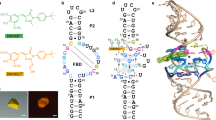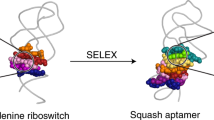Abstract
2-Aminopurine (2AP) is a fluorescent isomer of adenine and has a fluorescence lifetime of ~11 ns in water. It is widely used in biochemical settings as a site-specific fluorescent probe of DNA and RNA structure and base-flipping and -folding. These assays assume that 2AP is intrinsically strongly fluorescent. Here, we show this not to be the case, observing that gas-phase, jet-cooled 2-aminopurine and 9-methyl-2-aminopurine have very short fluorescence lifetimes (156 ps and 210 ps, respectively); they are, to all intents and purposes, non-fluorescent. We find that the lifetime of 2-aminopurine increases dramatically when it is part of a hydrate cluster, 2AP·(H2O)n, where n = 1–3. Not only does it depend on the presence of water molecules, it also depends on the specific hydrogen-bonding site to which they attach and on the number of H2O molecules at that site. We selectively microhydrate 2-aminopurine at its sugar-edge, cis-amino or trans-amino sites and see that its fluorescence lifetime increases by 4, 50 and 95 times (to 14.5 ns), respectively.
This is a preview of subscription content, access via your institution
Access options
Subscribe to this journal
Receive 12 print issues and online access
$259.00 per year
only $21.58 per issue
Buy this article
- Purchase on Springer Link
- Instant access to full article PDF
Prices may be subject to local taxes which are calculated during checkout



Similar content being viewed by others
References
Ward, D. C., Reich, E. & Stryer, L. Fluorescence studies of nucleotides and polynucleotides. J. Biol. Chem. 244, 1228–1239 (1969).
Guest, C. R., Hochstrasser, R. A., Sowers, L. C. & Millar, D. P. Dynamics of mismatched base pairs in DNA. Biochemistry 30, 3271–3279 (1991).
Allan, B. W. & Reich, N. O. Targeted base stacking disruption by the EcoRI DNA methyltransferase. Biochemistry 35, 14757–14762 (1996).
Stivers, J. T. 2-Aminopurine fluorescence studies of base stacking interactions at abasic sites in DNA: metal-ion and base sequence effects. Nucleic Acids Res. 26, 3837–3844 (1998).
Kelley, S. O. & Barton, J. K. Electron transfer between bases on double helical DNA. Science 283, 375–381 (1999).
Wan, C., Fiebig, T., Schiemann, O., Barton, J. K. & Zewail, A. H. Femtosecond direct observation of charge transfer between bases in DNA. Proc. Natl Acad. Sci. USA 97, 14052–14055 (2000).
Jiao, Y., Stringfellow, S. & Yu, H. Distinguishing ‘looped-out’ and ‘stacked-in’ DNA bulge conformation using fluorescent 2-aminopurine replacing a purine base. J. Biomol. Struct. Dyn. 19, 929–934 (2002).
Pal, S. K., Peon, J. & Zewail, A. H. Ultrafast decay and hydration dynamics of DNA bases and mimics. Chem. Phys. Lett. 363, 57–63 (2002).
Pal, S. K., Zhao, L., Xia, T. & Zewail, A. H. Site- and sequence-selective ultrafast hydration of DNA. Proc. Natl Acad. Sci. USA 100, 13746–13751 (2003).
Lee, B. J., Barch, M., Castner, E. W., Völker, J. & Breslauer, K. J. Structure and dynamics in DNA looped domains: CAG triplet repeat sequence dynamics probed by 2-aminopurine fluorescence. Biochemistry 46, 10756–10766 (2007).
Wilcox, J. L. & Bevilacqua, P. C. A simple fluorescence method for pKa determination in RNA and DNA reveals highly shifted pKas. J. Am. Chem. Soc. 135, 7390–7393 (2013).
Fagan, P. A., Fàbrega, C., Eritja, R., Goodman, M. F. & Wemmer, D. E. NMR study of the conformation of the 2-aminopurine:cytosine mismatch in DNA. Biochemistry 35, 4026–4033 (1996).
Sowers, L. C., Fazakerley, G. V., Eritja, R., Kaplan, B. E. & Goodman, M. F. Base pairing and mutagenesis: observation of a protonated base pair between 2-aminopurine and cytosine in an oligonucleotide by proton NMR. Proc. Natl Acad. Sci. USA 83, 5434–5438 (1986).
Rachofsky, E. L., Osman, R. & Ross, J. B. Probing structure and dynamics of DNA with 2-aminopurine: effects of local environment on fluorescence. Biochemistry 40, 946–949 (2001).
Neely, R. K. et al. Time-resolved fluorescence of 2-aminopurine as a probe of base flipping in M.Hhal–DNA complexes. Nucleic Acids Res. 33, 6953–6960 (2005).
Smagowicz, J. & Wierzchowski, K. L. Lowest excited states of 2-aminopurine. J. Lumin. 8, 210–218 (1974).
Allan, B. W., Reich, N. O. & Beechem, J. M. Measurement of the absolute temporal coupling between DNA binding and base flipping. Biochemistry 38, 5308–5314 (1999).
Jean, J. M. & Hall, K. B. 2-Aminopurine fluorescence quenching and lifetimes: role of base stacking. Proc. Natl Acad. Sci. USA 98, 37–41 (2001).
Rachofsky, E. L., Seibert, E., Stivers, J. T., Osman, R. & Ross, J. B. Conformation and dynamics of abasic sites in DNA investigated by time-resolved fluorescence of 2-aminopurine. Biochemistry 40, 957–967 (2001).
Souliére, M. F., Haller, A., Rieder, R. & Micura, R. A Powerful approach for the selection of 2-aminopurine substitution sites to investigate RNA folding. J. Am. Chem. Soc. 133, 16161–16167 (2011).
Rist, M. J. & Marino, J. P. Fluorescent nucleotide base analogs as probes of nucleic acid structure, dynamics and interaction. Curr. Org. Chem. 6, 775–793 (2002).
Broo, A. A theoretical investigation of the physical reason for the very different luminescence properties of the two isomers adenine and 2-aminopurine. J. Phys. Chem. A 102, 526–531 (1998).
Jean, J. M. & Hall, K. B. Theoretical study of the excited state properties and transitions of 2-aminopurine in the gas phase and in solution. J. Phys. Chem. A 104, 1930–1937 (2000).
Rachofsky, E. L., Ross, J. B. A., Krauss, M. & Osman, R. CASSCF investigation of electronic excited states of 2-aminopurine. J. Phys. Chem. A 105, 190–197 (2001).
Serrano-Andrés, L., Merchán, M. & Borin, A. Adenine and 2-aminopurine: paradigms of modern theoretical photochemistry. Proc. Natl Acad. Sci. USA 103, 8691–8696 (2006).
Perun, S., Sobolewski, A. L. & Domcke, W. Ab initio studies of the photophysics of 2-aminopurine. Mol. Phys. 104, 1113–1121 (2006).
Ludwig, V., Serrou do Amaral, M., da Costa, Z. M., Borin, A. C., Canuto, S. & Serrano-Andrés, L. 2-Aminopurine non-radiative decay and emission in aqueous solution: a theoretical study. Chem. Phys. Lett. 463, 201–205 (2008).
Lim, E. C. Proximity effect in molecular photophysics: dynamic consequences of pseudo-Jahn–Teller interaction. J. Phys. Chem. 90, 6770–6777 (1986).
Seefeld, K. A. et al. Tautomers and electronic states of jet-cooled 2-aminopurine investigated by double resonance spectroscopy and theory. Phys. Chem. Chem. Phys. 7, 3021–3026 (2005).
Sinha, R. K., Lobsiger, S., Trachsel, M. & Leutwyler, S. Vibronic spectra of jet-cooled 2-aminopurine·H2O clusters studied by UV resonant two-photon ionization spectroscopy and quantum chemical calculations. J. Phys. Chem. A 115, 6208–6217 (2011).
Trachsel, M., Lobsiger, S., Schär, T. & Leutwyler, S. Low-lying excited-states and nonradiative processes of 9-methyl-2-aminopurine. J. Chem. Phys. 140, 044331 (2014).
Sinha, R. K., Lobsiger, S. & Leutwyler, S. Isomer- and species-selective infrared spectroscopy of jet-cooled 7H- and 9H-2-aminopurine and 2-aminopurine·H2O clusters. J. Phys. Chem. A 116, 1129–1136 (2012).
Lobsiger, S., Sinha, R. K. & Leutwyler, S. Building up water-wire clusters: isomer-selective ultraviolet and infrared spectra of jet-cooled 2-aminopurine (H2O)n, n = 2 and 3. J. Phys. Chem. B 117, 12410–12421 (2013).
TURBOMOLE V6.3 2011 (Universität Karlsruhe, Forschungszentrum Karlsruhe, TURBOMOLE); available from http://www.turbomole.com
Improta, R. & Barone, V. Absorption and fluorescence spectra of uracil in the gas phase and in aqueous solution: a TD-DFT quantum mechanical study. J. Am. Chem. Soc. 126, 14320–14321 (2004).
Etinski, M. & Marian, C. M. Ab initio investigation of the methylation and hydration effects on the electronic spectra of uracil and thymine. Phys. Chem. Chem. Phys. 12, 4915–4923 (2010).
Lobsiger, S., Sinha, R. K., Trachsel, M. & Leutwyler, S. Low-lying excited-states and nonradiative processes of the adenine analogues 7H- and 9H-2-aminopurine. J. Chem. Phys. 134, 114307 (2011).
Acknowledgements
The authors acknowledge financial support from the Schweiz Nationalfonds (SNSF; project numbers 20020-121993 and 200021-132540).
Author information
Authors and Affiliations
Contributions
S.Lo. and R.K.S. performed the nanosecond spectroscopic and pump–probe experiments as well as the DFT calculations, and analysed the spectroscopic and nanosecond kinetic data. S.B. co-designed the picosecond pump–probe experiment and performed the picosecond pump–probe measurements. H.M.F. conceived and designed the picosecond pump–probe experiments and programmed the kinetic fitting analysis. S.Lo. and S.Le. wrote major parts of the manuscript.
Corresponding author
Ethics declarations
Competing interests
The authors declare no competing financial interests.
Supplementary information
Supplementary information
Supplementary information (PDF 1047 kb)
Rights and permissions
About this article
Cite this article
Lobsiger, S., Blaser, S., Sinha, R. et al. Switching on the fluorescence of 2-aminopurine by site-selective microhydration. Nature Chem 6, 989–993 (2014). https://doi.org/10.1038/nchem.2086
Received:
Accepted:
Published:
Issue Date:
DOI: https://doi.org/10.1038/nchem.2086
This article is cited by
-
Fluorescent nucleobases as tools for studying DNA and RNA
Nature Chemistry (2017)



